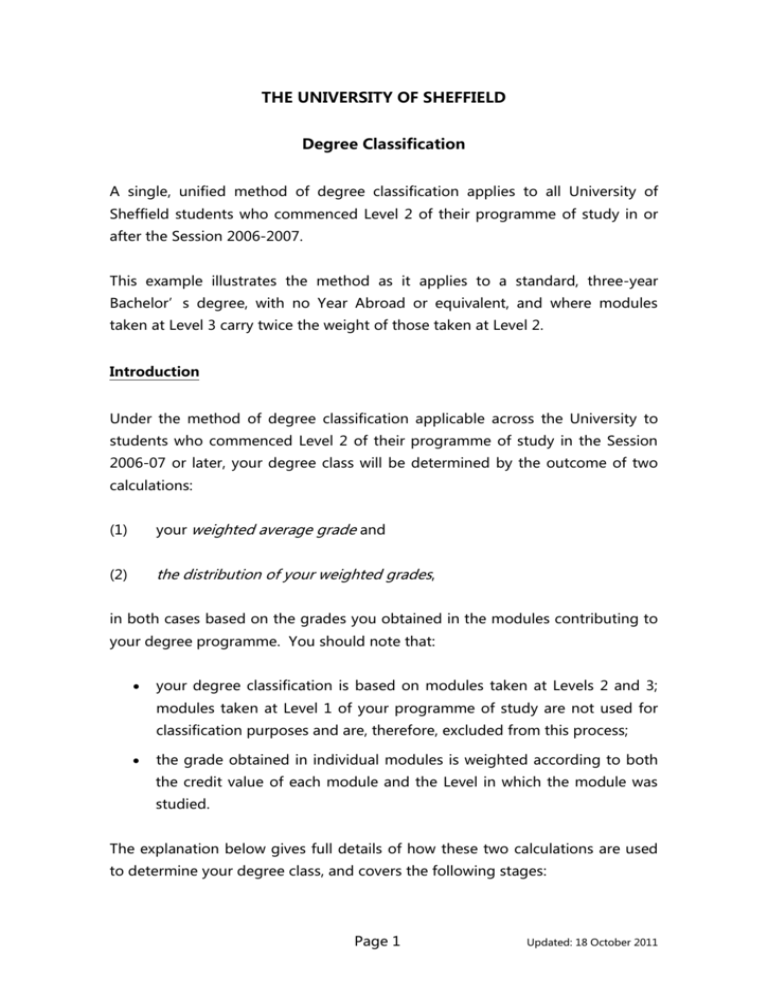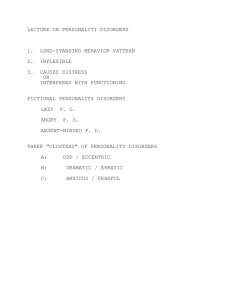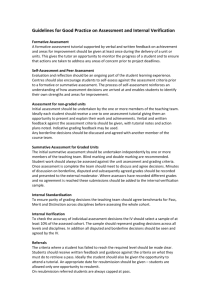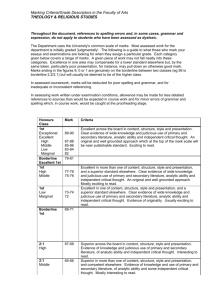Guidance on Degree Classification Methodology
advertisement

THE UNIVERSITY OF SHEFFIELD Degree Classification A single, unified method of degree classification applies to all University of Sheffield students who commenced Level 2 of their programme of study in or after the Session 2006-2007. This example illustrates the method as it applies to a standard, three-year Bachelor’s degree, with no Year Abroad or equivalent, and where modules taken at Level 3 carry twice the weight of those taken at Level 2. Introduction Under the method of degree classification applicable across the University to students who commenced Level 2 of their programme of study in the Session 2006-07 or later, your degree class will be determined by the outcome of two calculations: (1) your weighted average grade and (2) the distribution of your weighted grades, in both cases based on the grades you obtained in the modules contributing to your degree programme. You should note that: your degree classification is based on modules taken at Levels 2 and 3; modules taken at Level 1 of your programme of study are not used for classification purposes and are, therefore, excluded from this process; the grade obtained in individual modules is weighted according to both the credit value of each module and the Level in which the module was studied. The explanation below gives full details of how these two calculations are used to determine your degree class, and covers the following stages: Page 1 Updated: 18 October 2011 (a) Preparation of your grade profile: (i) weighting of modules by credit value, to take account of the fact that different modules may carry different credit values; (ii) weighting by Level, to take account of the fact that Level 3 modules carry twice the weight of those taken at Level 2. (b) Calculation 1: your weighted average grade. (c) Calculation 2: the distribution of your weighted grades. (d) Determination of your degree class. However, you should note that regardless of the outcome of the determination of your degree class using the above methodology, you must have obtained a sufficient number of credits at Level 2 and above for a degree to be awarded, as detailed in the University's General Regulations for First Degrees. Example (a) Preparation of your grade profile (i) Weighting of modules by credit value 1. Suppose the module grades you obtain at Levels 2 and 3 of your Bachelor’s degree are as follows: Grades obtained at Level 2 Credit value 10 10 10 10 20 20 20 20 Grade 62 63 64 85 73 62 59 60 obtained Grades obtained at Level 3 Credit value 10 10 20 20 60 Grade 62 58 64 65 68 Page 2 Updated: 18 October 2011 obtained 2. Your module grades are first weighted by credit value by converting all modules with a value greater than 10 credits into elements of 10 credits each. In this way, for example, a grade of 73 for a 20-credit module is expressed as: Credit value 10 10 Grade 73 73 obtained In this example, your resulting grade profile would be as follows. Grades obtained at Level 2 (weighted by credit value) Credit value 10 10 10 10 10 10 10 10 10 10 10 10 Grade 62 63 64 85 73 73 62 62 59 59 60 60 obtained Grades obtained at Level 3 (weighted by credit value) Credit value 10 10 10 10 10 10 10 10 10 10 10 10 Grade 62 58 64 64 65 65 68 68 68 68 68 68 obtained (ii) Weighting by Level 3. Your module grades, once weighted by credit value, are subject to a further ‘level-weighting’. That is, your Level 3 grades are counted twice relative to those obtained at Level 2, giving the following grade profile: Grades obtained at Level 2 (weighted by credit value and level) Page 3 Updated: 18 October 2011 Credit value 10 10 10 10 10 10 10 10 10 10 10 10 Grade 62 63 64 85 73 73 62 62 59 59 60 60 obtained Grades obtained at Level 3 (weighted by credit value and level) Credit value 10 10 10 10 10 10 10 10 10 10 10 10 Grade 62 58 64 64 65 65 68 68 68 68 68 68 Credit value 10 10 10 10 10 10 10 10 10 10 10 10 Grade 62 58 64 64 65 65 68 68 68 68 68 68 obtained obtained 4. This is the grade profile which is used to generate two preliminary classifications based on (1) your weighted average grade and (2) the distribution of your weighted grades. (b) Calculation 1: your weighted average grade 5. A preliminary classification based on the weighted average of your grades is obtained by taking the average of the grades in the 36 x 10credit elements detailed in 3 above. In this example, your weighted average grade is thus: the sum of the grades obtained (62+63+64+85+73+73+62+62+59+59+60+60+62+58+64+64+65+65+ 68+68+68+68+68+68+62+58+64+64+65+65+68+68+68+68+68+68 = 2354) divided by the number of 10-credit elements 2354 ÷ 36 = 65.4 (i.e. rounded to one decimal point) 5.1 Your weighted average grade is converted to a preliminary degree classification according to the following: Page 4 Updated: 18 October 2011 Weighted average grade Degree class ≥ 69.5 First ≥ 68.0 and < 69.5 First/2.1 borderline range ≥ 59.5 and < 68.0 2.1 ≥ 58.0 and < 59.5 2.1/2.2 borderline range ≥ 49.5 and < 58.0 2.2 ≥ 48.0 and < 49.5 2.2/Third borderline range ≥ 44.5 and < 48.0 Third ≥ 43.5 and < 44.5 Third/Pass borderline range ≥ 39.5 and < 43.5 Pass ≥ 38.0 and < 39.5 Pass/Fail borderline range < 38.0 Fail In this example, therefore, your weighted average grade of 65.4, via Calculation 1, indicates a preliminary classification of 2.1. (c) Calculation 2: the distribution of your weighted grades 6. A second preliminary classification based on the distribution of your weighted grades is obtained by ranking the 36 10-credit elements and identifying the 18th ranked grade, as follows: Rank Grade Rank 1 85 19 65 2 73 20 64 3 73 21 64 4 68 22 64 5 68 23 64 6 68 24 64 Page 5 Grade Updated: 18 October 2011 18th ranked grade 6.1 7 68 25 63 8 68 26 62 9 68 27 62 10 68 28 62 11 68 29 62 12 68 30 62 13 68 31 60 14 68 32 60 15 68 33 59 16 65 34 59 17 65 35 58 18 65 36 58 In this example, your 18th ranked grade is 65. This grade is converted to a preliminary degree classification according to the following: Grade Degree class ≥ 69.5 First ≥ 59.5 and <69.5 2.1 ≥ 49.5 and <59.5 2.2 ≥ 44.5 and <49.5 Third ≥ 39.5 and <44.5 Pass < 39.5 Fail In the above example, therefore, the distribution of your grades, via Calculation 2, is a preliminary classification of 2.1. 6.2 To determine whether, for the purposes of Calculation 2, you should be placed in the borderline range to a higher degree class, it is also necessary to establish whether the 15th ranked grade corresponds to a different class than that arrived at under 6.1. If so, you are placed in the borderline range. Page 6 Updated: 18 October 2011 In the current example, although the 15th ranked grade is higher than the 18th, it is less than 69.5 (the lowest grade in the first class band, as set out in 6.1 above), and the preliminary classification indicated by Calculation 2 is therefore still 2.1. 15th ranked grade (d) Rank Grade Rank Grade 1 85 19 65 2 73 20 64 3 73 21 64 4 68 22 64 5 68 23 64 6 68 24 64 7 68 25 63 8 68 26 62 9 68 27 62 10 68 28 62 11 68 29 62 12 68 30 62 13 68 31 60 14 68 32 60 15 68 33 59 16 65 34 59 17 65 35 58 18 65 36 58 Determination of your degree class 7. The outcomes of Calculation 1 and Calculation 2 are combined to give a classification according to the principles given below. Where your weighted average grade and the distribution of your weighted grades both indicate that you should be awarded the same class of degree, this is the class of degree that you will receive. Where Page 7 Updated: 18 October 2011 one of these calculations indicates that you should be awarded a particular class of degree, but the other places you in the borderline range to that class, you will still be awarded the higher class. However, should one calculation indicate that you should be awarded a particular class of degree but the other indicates that you should be awarded the class below, you will become a borderline candidate to the higher class. Or if both calculations place you in the borderline range to a higher class you will also become a borderline candidate to the higher class. In both situations the class of degree you receive will be decided by the Examination Board with reference to the average weighted grade of the modules you studied during your final Level. Page 8 Updated: 18 October 2011 8. The full scheme by which Calculations 1 and 2 are combined to give a combined classification is detailed below. Calculation 1: Calculation 2: Preliminary Preliminary Combined classification classification classification First First First First Borderline First First First 2.1 Borderline First Borderline First First First Borderline First Borderline First Borderline First Borderline First 2.1 2.1 2.1 First Borderline First 2.1 Borderline First 2.1 2.1 2.1 2.1 2.1 Borderline 2.1 2.1 2.1 2.2 Borderline 2.1 Borderline 2.1 2.1 2.1 Borderline 2.1 Borderline 2.1 Borderline 2.1 Borderline 2.1 2.2 2.2 2.2 2.1 Borderline 2.1 2.2 Borderline 2.1 2.2 2.2 2.2 2.2 2.2 Borderline 2.2 2.2 2.2 Third Borderline 2.2 Borderline 2.2 2.2 2.2 Borderline 2.2 Borderline 2.2 Borderline 2.2 Borderline 2.2 Third Third Third 2.2 Borderline 2.2 Third Borderline 2.2 Third Third Third Third Third Borderline Third Third Third Pass Borderline Third Borderline Third Third Third Borderline Third Borderline Third Borderline Third Borderline Third Pass Pass Page 9 Updated: 18 October 2011 Pass Third Borderline Third Pass Borderline Third Pass Pass Pass Pass Pass Borderline Pass Pass Pass Fail Borderline Pass Borderline Pass Pass Pass Borderline Pass Borderline Pass Borderline Pass Borderline Pass Fail Fail Fail Pass Borderline Pass Fail Borderline Pass Fail Fail Fail Fail In the current example, the outcomes of both Calculations 1 and 2 indicate a preliminary degree classification of 2.1. This results in a combined classification of 2.1. 9. In considering candidates whose combined classification is borderline, the class of degree to be recommended by the Examiners will normally correspond to the class indicated by the average of the grades you obtained at your final Level of study (Level 3 in this example) weighted by credit value, according to the following: Weighted average grade Degree class at final Level of study 10. ≥ 69.5 First ≥ 59.5 and < 69.5 2.1 ≥ 49.5 and < 59.5 2.2 ≥ 44.5 and < 49.5 Third ≥ 39.5 and < 44.5 Pass < 39.5 Fail If the particular combination of preliminary classifications you obtained for Calculation 1 and Calculation 2 is not shown in the table in section 8, then the Examiners will recommend a degree classification which, having Page 10 Updated: 18 October 2011 regard to all the evidence before them, best reflects your overall performance. Other Considerations 11. It should be noted that regardless of the outcomes of the determination of your degree class using the above methodology, you must have obtained a sufficient number of credits at Level 2 and above for a degree to be awarded, as detailed in the University General Regulations for First Degrees, available at (www.shef.ac.uk/calendar) 12. If you have submitted evidence of mitigating circumstances (e.g. medical/ personal) to your department, these may be taken into account by the Examination Board when recommending the class of degree to be awarded. Additional Information 13. Integrated Masters degrees, such as the MEng, MChem and MPhys, are classified in an analogous fashion. The Level-weighting for Levels 2, 3 and 4 of such programmes where a year in industry or abroad is not involved is 1:2:2. In this way, modules taken at Levels 3 and 4 carry twice the weight of those taken at Level 2. For Integrated Masters degrees, Calculation 2 uses the 30th ranked grade and 25th ranked grade (rather than the 18th and 15th) when determining the preliminary classification and whether it is in a borderline range or not. 14. If your programme of study involves a credit-bearing year in industry or abroad, you should confirm with your department the level-weighting that will apply in classifying your degree. 15. If your degree includes any 5-credit modules, then for the purposes of determining your combined classification the following would apply: Page 11 Updated: 18 October 2011 Prepare your grade profile (see section (a) in the example above) by converting all your modules with a value greater than 5 credits into elements of 5 credits each (instead of converting all modules with a value greater than 10 credits into elements of 10 credits each). So, for example, a grade of 73 for a 20-credit module would be expressed as: Credit value 5 5 5 5 Grade 73 73 73 73 obtained For Calculation 1 (see section (b) in the example above), in order to calculate your weighted average grade, sum all the grades obtained in the profile and divide by the number of 5-credit elements (72 for the 3year Bachelors degree in the example). For Calculation 2 (see section (c) in the example above), rank the 72 5credit elements and identify the 36th and 30th ranked grades. 16. If you commenced Level 3 or Level 4 of your degree in September 2010 then the borderline ranges for Calculation 1 are as stated below (rather than those stated earlier in the table at point 5.1 of section d): Weighted average grade Degree class ≥ 69.5 First ≥ 67.0 and < 69.5 First/2.1 borderline range ≥ 59.5 and < 67.0 2.1 ≥ 57.0 and < 59.5 2.1/2.2 borderline range ≥ 49.5 and < 57.0 2.2 ≥ 47.0 and < 49.5 2.2/Third borderline range ≥ 44.5 and < 47.0 Third ≥ 43.5 and < 44.5 Third/Pass borderline range ≥ 39.5 and < 43.5 Pass ≥ 37.0 and < 39.5 Pass/Fail borderline range Page 12 Updated: 18 October 2011 < 37.0 Fail Learning & Teaching Services Updated 18 October 2011 Page 13 Updated: 18 October 2011









